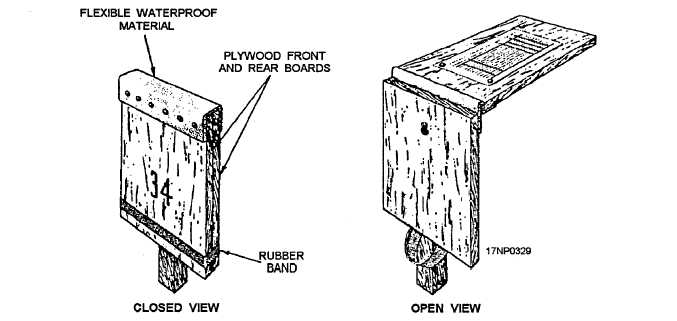3. Safety precautions and regulations that pertain
to the specific material presently stored in the
magazine or building.
Post this information at each outside (open)
ammunition storage site. Print the information on a card
so it is protected from the weather. Then, put the card
in a locally manufactured ammunition site sign and card
holder, as shown in figure 12-8.
Advanced base magazines are built in the most
suitable location for storing one of the three hazard
classifications-explosion, fire, or fragment. Since all
advanced base magazines are of the same type of
construction, all three hazard classifications may be
stored in them if they are within Q-D limitations.
However, the group construction symbol designates the
type of storage for which the magazine is most suitable.
Don’t change this symbol to show the magazine’s
present or new use, unless the change is permanent.
DISPERSION OF AMMUNITION
Ammunition dispersement is a main consideration
inlaying out an ammunition storage area at an advanced
base. Each type of ammunition is stored in two widely
separated areas. This prevents losing an entire supply
of an ammunition item if there is a fire or explosion.
Explosive stores are separated from other stores, as
specified in the Q-D tables.
Group piles of ammunition stored in the open by
categories. These groups are discussed in the following
paragraphs. These groupings aren’t compatibility
groups; they are only used to ensure safe distances are
maintained between piles and stacks of ammunition.
CATEGORY A. This category of material presents
a fire hazard. It includes propelling charges, bag
charges, rocket motors, pyrotechnics, and small arms
ammunition. Category A material should be separated
from materials in the other categories (B through E) by
at least 350 feet.
CATEGORY B. This category of material presents
fire and fragment or fragment and explosion hazards. It
includes fixed ammunition, separate loading projectiles,
complete rockets (assembled or unassembled),
grenades, and mortars. Category B material should be
separated from materials in the other categories by at
least 300 feet.
CATEGORY C. This category of material presents
an explosion hazard This category includes bombs,
warheads, depth charges, mines, demolition material,
and bulk explosives. Category C material should be
separated from materials in the other categories by at
least 695 feet.
CATEGORY D. This category of material
includes fuzes and detonators. Category D material
should be separated from materials in the other
categories by at least 200 feet.
CATEGORY E. This category of material includes
chemical ammunition. Category E material should be
separated from materials in the other categories by at
least 400 feet.
Figure 12-8.—Ammunition site sign and card holder.
12-18


